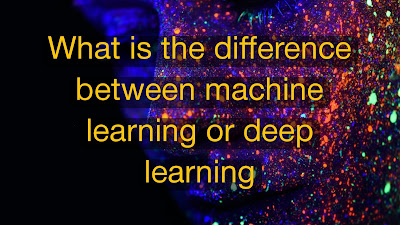What's the difference between ML and DL
Machine Learning (ML) and Deep Learning (DL) are both subfields of artificial intelligence (AI) that involve the development of algorithms that can learn from data and make predictions or decisions without being explicitly programmed. However, there are some key differences between them.
Approach: ML algorithms use traditional methods, such as linear and logistic regression, decision trees, and random forests, to make predictions or decisions. DL algorithms, on the other hand, use deep neural networks with multiple layers to learn and make predictions.
Complexity: ML algorithms are typically less complex than DL algorithms, which can have many layers and millions of neurons.
Data Requirements: ML algorithms typically work best with structured data, such as tables with rows and columns, while DL algorithms can handle unstructured data, such as images and audio, much better.
Automation: ML algorithms require some level of human intervention and feature engineering to get the best results. DL algorithms, however, can automatically learn features from the data and thus are more automated.
Machine Learning (ML)
Machine Learning is a subfield of artificial intelligence (AI) that focuses on the development of algorithms and models that can learn from data and make predictions or decisions without being explicitly programmed. The goal of ML is to develop algorithms that can automatically improve their performance through experience.
There are three main types of ML:
Supervised Learning: In supervised learning the algorithm is trained on a labeled dataset which means that the correct answers are provided for the algorithm to learn from. The algorithm makes predictions on new, unseen data based on the patterns it has learned from the labeled data. Examples of supervised learning algorithms include linear regression, logistic regression, and decision trees.
Unsupervised Learning: In unsupervised learning, the algorithm is trained on an unlabeled dataset, meaning that the correct answers are not provided. The algorithm must find the patterns or relationships in the data on its own. Examples of unsupervised learning algorithms include clustering and dimensionality reduction.
Reinforcement Learning: Reinforcement learning is a type of ML where an agent learns to make decisions by taking actions in an environment and receiving rewards or punishments based on the results of those actions. The goal is for the agent to learn the optimal policy for maximizing the rewards.
Deep Learning (DL):
Deep Learning is a subset of Machine Learning that uses deep neural networks, which are composed of many layers of artificial neurons, to model complex patterns in data. Deep learning algorithms are designed to automatically learn features and representations from raw data, making them well-suited for handling large amounts of unstructured data, such as images, audio, and text.
Deep learning models can be trained in a supervised, unsupervised, or reinforcement learning setting, but they are most commonly used in supervised learning tasks. Some examples of deep learning applications include image classification, speech recognition, natural language processing, and game playing.
In conclusion, both Machine Learning and Deep Learning are important subfields of AI that have the potential to revolutionize the way we live and work. Machine Learning focuses on building algorithms that can learn from data, while Deep Learning specifically uses deep neural networks to model complex patterns in data.





0 Comments